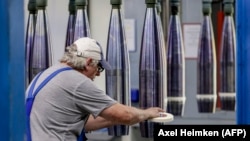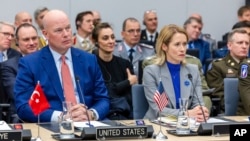
Welcome to Wider Europe, RFE/RL's newsletter focusing on the key issues concerning the European Union, NATO, and other institutions and their relationships with the Western Balkans and Europe's Eastern neighborhoods.
I'm RFE/RL Europe Editor Rikard Jozwiak, and this week I am drilling down on two issues: the EU’s attempt to ramp up its defense and the bloc finally hitting Russian fertilizers.
Briefing #1: Brussels’ $170 Billion Plan To Boost European Defense Capabilities
What You Need To Know: On May 27, the European Union will formally approve its 150 billion euro ($170 billion) scheme to boost defense spending in the bloc.
The so-called SAFE (Security Action For Europe) regulation was first proposed in March by the European Commission in response to calls from member states for financial and political support to meet new defense targets pushed by NATO -- and to potentially step in for Ukraine, should the United States shift its focus elsewhere.
The final regulation, seen by RFE/RL, spells out clearly that “the threats posed by Russia and Belarus are of particular urgency and relevance,” and need to be countered quickly.
Due to the time required to develop defense products and scale up industrial production capacity across the EU, the regulation also says it will be “vital” for the union to start supporting member states “as soon as possible so that they can place orders very rapidly.”
Brussels first responded to the member states’ calls by triggering the EU’s national escape clause for military spending, meaning that expenditure for items like weapons and ammunition won’t be accounted for in the bloc's punishment mechanism for countries breaching EU spending limits.
Deep Background: That created fiscal leeway -- but member states also need the cash as soon as possible. With several capitals keen to access the proposed funds quickly -- and with no need for unanimity or consent from the European Parliament -- EU ambassadors approved the new legislation on May 21, with only Hungary going against it.
The new scheme functions the same way as the EU’s recent COVID-19 recovery program, which was worth 800 billion euros ($920 billion).
For SAFE, the bloc will use its triple-A credit rating to raise the required 150 billion euros on the markets and then loan it to member states. In this sense it will be much cheaper than having most EU members trying to generate the funds themselves by borrowing separately.
Five EU countries -- Denmark, Germany, Luxembourg, the Netherlands, and Sweden -- currently enjoy a triple-A rating, so they most likely won’t need to participate in the scheme, leaving more of the potential loans for poorer members.
The fact that the loans have a maximum duration of 45 years, don’t need to be serviced in the first decade, and countries won’t have to pay VAT on the equipment purchased are other advantages that Brussels hopes will trigger a European defense splurge.
Drilling Down
- But there are, of course, some strings attached to all this. First of all, many indebted southern member states complain that -- unlike the COVID recovery scheme, which also included a grant component -- this initiative is exclusively a loan, which will place an even bigger burden on already strained public finances.
- SAFE is also supposed to stimulate joint defense procurements between countries, with the European Commission keen to use the instrument to create a proper European defense market instead of the nationally fragmented one that largely exists today.
- Countries can apply for loans without teaming up with another state during the first year only. After that -- from late 2026 to 2030 (when the scheme expires) -- two or more countries must apply jointly.
- In order to ensure the money is fairly distributed, the share of loans granted to the three member states getting the biggest allowance should not exceed 60 percent of the entire 150 billion euros allocated to the scheme.
- But the big issue in the past month has been who can participate in SAFE -- balancing various member states' desire to boost domestic production with the reality that not every component can be made in the EU.
- For starters, the countries in the European Free Trade Association (EFTA) -- Iceland, Liechtenstein, Norway, and Switzerland -- are included in the scheme. The same is true of EU candidate country Ukraine.
- The regulation justifies their inclusion by citing “those countries’ close partnership with the Union in industrial defense production” and the fact that “Ukraine is directly faced with Russia’s ongoing war of aggression.”
- Even so, there have still been grumbles. The United States, in particular, has complained about being locked out of this process. And many EU member states -- still keen to maintain transatlantic military links while also keeping other close partners involved in aspects of SAFE -- have also lobbied hard to open up the scheme to further outside participation.
- In the end, a “65-35 rule” was settled on. That means that 65 percent of the value of the weapon acquired has to be generated in the EU, the four EFTA countries, or Ukraine. The other 35 percent can be produced elsewhere, such as the United States, for example.
- But it gets a bit more complicated. If a country has a Security and Defense Partnership (SDP) with the EU, 65 percent of the value of the weapon can come from that state. The United Kingdom recently penned such a deal with the bloc -- and Albania, Japan, Moldova, North Macedonia, and South Korea also have similar deals in place.
- Ultimately, as one EU official who spoke to RFE/RL put it, the upshot is “a classic Brussels compromise” -- a rather big deal has been struck but the money won’t start flowing until everyone, including many outside the family, gets their fair share.
Briefing #2: The EU Finally Hits Russian And Belarusian Fertilizers
What You Need To Know: On May 22, the European Union took a major step toward getting rid of Russian and Belarusian nitrogen-based fertilizer imports in the bloc.
In a European parliament session in Brussels, EU lawmakers overwhelmingly voted to introduce gradual duties on such products, starting on July 1.
But Moscow and Minsk won’t feel the pain immediately.
The current 6.5 percent tariffs on fertilizers from the two countries will remain but what will be added are duties of 40 to 45 euros ($45-50) per ton up to mid-2026.
This is still not too much of a hit, and trade is still expected to happen. But then the duties will become gradually higher, rising to 60 euros ($68) per ton from mid-2026 and then to 80 euros ($90) per ton in 2027 before finally going up to 350 euros ($398) and 430 euros ($486) per ton by 2028, essentially making it economically unviable to buy the products from Belarus and Russia.
Deep Background: The move comes amid rising concerns about Europe's increasing dependence on fertilizers from Russia, where an abundance of cheap energy makes production -- and consequently the end product -- substantially cheaper.
In 2023, the bloc imported 3.6 millions tons, worth 1.28 billion euros ($20.4). This constituted 25 percent of total EU imports, making Russia the single biggest exporter of fertilizer to the EU.
Last year, this upward trend continued with 4.4 million tons of Russian fertilizers entering the European Union, taking the import share up to around 30 percent.
The fertilizer trade with Belarus is small -- worth just 30 million euros ($34 million) last year, but Brussels has decided to target it as well due to the close political and economic ties between Minsk and Moscow and the fear of Russian fertilizers entering via Belarus if the duty regime isn’t synchronized.
The proposal also increases EU tariffs by 50 percent on the value of Russian and Belarusian agricultural products such as sugar, vinegar, flour, and animal feed.
The bloc had previously been reluctant to hit Russian agricultural products with sanctions given accusations from poorer countries in Asia and Africa that such moves cause food shortages.
The situation has been somewhat alleviated over the past year with Ukraine resuming exports of its food produce via the Black Sea.
The European Union has also pledged that the transit of Russian and Belarusian agricultural exports through the bloc to the rest of the world is still possible.
Drilling Down
- The hope is that EU fertilizer producers can now step up to compensate for the shortfall caused by reduced Russian imports. While high energy prices may increase production costs, the proposal notes that the European industry still has about 20 percent spare capacity -- approximately 3 million tons -- despite some facility closures due to energy costs. In addition to the 9.5 million tons of nitrogen fertilizers exported in 2024, this unused capacity “could almost completely compensate for the shortfall of reducing Russian imports into the EU.”
- The EU is also hoping that the measures will mean a diversification of supplies with increased imports from countries like Algeria, Egypt, Morocco, and Oman, places Brussels is keen to forge closer relationships with.
- It has also not escaped the bloc’s attention that the United States wants to export more fertilizers. Following the suspension of US President Donald Trump’s April tariffs on the EU, some sort of larger transatlantic trade deal is possible, and this could very well be part of any potential package.
- All this means that the proposal has met with minimal opposition after being presented by the European Commission in late January. The 27 EU member states left the regulation completely untouched, which is quite rare, and in the vote in April only Hungary voted against it, with Belgium and Bulgaria abstaining.
- As this is a trade regulation, unanimity is not required -- only a qualified majority (55 percent of member states representing 65 percent of the EU population) and a simple majority in the European Parliament.
- This relatively new approach by Brussels -- using trade regulations to target Russian exports instead of sanctions, which require consensus -- may become a more frequent strategy for the EU to circumvent potential vetoes.
- In June, the European Commission is due to present several legislative proposals to phase out imports of Russian gas, nuclear materials, and oil over the next two years, using the same method as with the fertilizers.
Looking Ahead
On May 28, the European Commission will present its strategy for the Black Sea region -- an effort by Brussels to strengthen ties with countries such as Azerbaijan, Armenia, Georgia, Moldova, Turkey, and Ukraine amid growing Russian influence.
The document is expected to be short on concrete proposals and financial commitments, but will likely emphasize promises of closer cooperation on trade, security, and environmental protection.
That's all for this week!
Feel free to reach out to me on any of these issues on X @RikardJozwiak, or on e-mail at jozwiakr@rferl.org.
Until next time,
Rikard Jozwiak
If you enjoyed this briefing and don't want to miss the next edition subscribe here.

